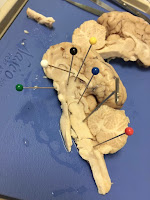In this lab we tested our different reflexes and how fast they are and how they function when fatigued. We recorded our data and than we put it in a class average. Our reflexes help us respond instantaneously and super fast.
Our photopupillary reflex is when the pupil adjust to light. Humans adapted to this so when it is dark out we do not just go blind, we can actually see. Our eyes adapt which is good for survival and is a good key to living. Some may say that it is survival of the fittest, who ever can adapt will be successful.
The knee jerk reflex of the Patellar reflex is when we get a tap on the knee at the doctors. I used to love this one as a kid but i never knew what it was. When the hammer hits your knee in the right spot it should shoot up. It is called the monosynaptic reflex because of the one synapse in the curcuit that helps kick out the leg. When I did 30 squats the muscles were fatigued which caused the reaction to die down because of a lack of ATP flowing through my body. The humans blink reflex is shown when something is a possible threat to the eye. Before doing it I thought that it wud be easy not to blink, but when it was happening it was a natural reflex to blink to protect my eyes. I would say the only time I dont blink when something is thrown at my face is if it is a football. We have this reflex to protect our eyes from intruders that could harm us. We than tested our plantar reflex. The reaction to this test was that the foot would move inward and tense up. Someone with multiple scerosis would most likley show babinski's sign because the nerves would be damaged and not functioning properly. WE than tested how fast we really are by dropping a ruler and testing where we caught it. I have been awake for a while and worked out this morning so my reaction time was pretty fast. Others who may have just woke up had slower time. This showed that the signal that told my brain from my hand to grab the ruler was faster than other peoples. When I did this while I was texting my reaction time slowed down because my brain had to take its time off of texting and onto the next task that was grabbing the ruler.







